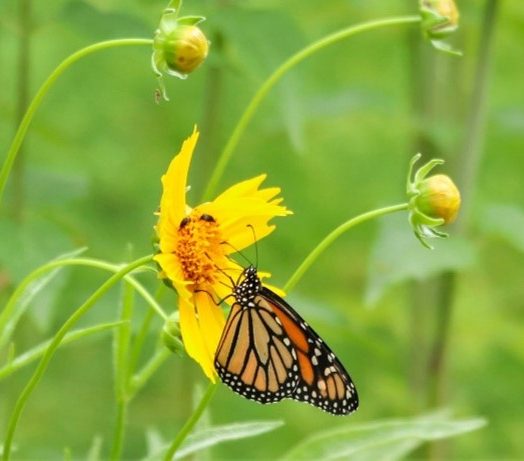PUBLISHED: April 2025 by Houston Parks Board
The Importance of Pollinator Gardens for Monarch Butterflies in the Spring
Spring is a season of renewal, growth, and vibrant life, making it the perfect time to establish and maintain pollinator gardens. These gardens not only add beauty to our surroundings but also serve a critical ecological function by supporting pollinators such as bees, butterflies, and hummingbirds. Among these pollinators, monarch butterflies stand out as an iconic and vital species. Their presence in the spring heralds the arrival of warmer weather and the beginning of an intricate cycle of pollination that benefits both native plants and agricultural crops. Pollinators are essential to biodiversity and food production. They are responsible for fertilizing flowers by transferring pollen from one bloom to another, enabling the production of fruits and seeds. Without pollinators, many plant species — including those that provide food for humans and wildlife — would struggle to reproduce. According to the U.S. Department of Agriculture (USDA), about 75% of flowering plants and 35% of global food crops rely on animal pollinators
MOnarch Butterflies: A Species in Decline
Monarch butterflies (Danaus plexippus) are one of the most well-known pollinators, admired for their striking orange and black coloration and their incredible migratory journey. Each year, monarchs travel thousands of miles from Mexico to breeding grounds across North America. However, habitat destruction, climate change, pesticide use, and other environmental threats have led to a significant decline in their population. The International Union for Conservation of Nature (IUCN) recently classified monarch butterflies as endangered, underscoring the urgency of conservation efforts

Spring is a crucial time for monarch butterflies as they emerge from their overwintering sites and begin their northward migration. During this time, female monarchs lay eggs on milkweed plants — the only host plant their caterpillars can eat. The availability of milkweed and nectar-rich flowers during the spring months directly impacts their reproductive success and the continuation of their journey. A lack of suitable habitat in the early months of the year can lead to reduced monarch populations later in the season.
Creating a Pollinator Garden to Support Monarchs and Other Pollinators
Establishing a pollinator garden is one of the most effective ways to support monarch butterflies and other pollinators. By planting native flowers, shrubs, and trees that provide nectar and habitat — homeowners, schools, and community organizations can create safe havens for these essential creatures.
Choosing the Right Plants
When designing a pollinator garden, selecting the right plants is key. Native plants are ideal because they have co-evolved with local pollinators and provide the most suitable food and
habitat. For monarchs, milkweed (Asclepias spp.) is a must-have, as it serves as the primary host plant for their caterpillars. Some of the best nectar-producing flowers for monarchs and other pollinators include:
- Milkweed (Asclepias spp.) – Essential for monarch larvae (DO NOT USE TROPICAL MILKWEED)
- Coneflowers (Echinacea spp.) – Attracts butterflies and bees
- Black-eyed Susan (Rudbeckia hirta) – Provides nectar for various pollinators
- Liatris (Liatris spicata) – A favorite among butterflies
- Bee Balm (Monarda spp.) – Attracts bees, butterflies, and hummingbirds
- Goldenrod (Solidago spp.) – Supports migrating monarchs in the fall
Providing Shelter and Water Sources
Beyond planting flowers, a pollinator garden should include elements that offer shelter and water. Dense clusters of flowers, shrubs, and small trees provide places for butterflies to rest and hide from predators. Flat stones in sunny areas allow butterflies to bask and regulate their body temperature. Additionally, a shallow dish with water and damp sand can serve as a hydration source for butterflies and bees.
The Broader Benefits of Pollinator Gardens
Pollinator gardens not only support butterflies and bees but also offer broader environmental and societal benefits. These gardens help combat climate change by promoting plant diversity and improving soil health. They also enhance urban greenspaces, providing educational opportunities for communities and inspiring future generations to appreciate nature. Additionally, supporting pollinators helps sustain food crops, which benefits farmers and consumers alike.
How You Can Get Involved
There are many ways individuals and communities can contribute to pollinator conservation beyond planting a garden:
- Join local conservation programs – Many organizations focus on restoring pollinator habitats and welcome volunteers.
- Participate in citizen science projects – Programs like the Monarch Watch Tagging Program allow individuals to track monarch migration.
- Advocate for pollinator-friendly policies – Support local and national initiatives that protect habitats and regulate pesticide use.
- Educate others – Share knowledge about the importance of pollinators through social media, workshops, or school programs.
Spring is a season of renewal and opportunity, making it the perfect time to take action for pollinators. By creating pollinator gardens and fostering environments rich in native plants, we can support monarch butterflies and other essential species. The decline of monarchs serves as a reminder of our interconnectedness with nature, emphasizing the need for conservation efforts. Whether through planting milkweed, reducing pesticide use, or spreading awareness, each action contributes to a healthier ecosystem and a more vibrant natural world. Let this spring be a season of positive change — one garden at a time.
Note: This blog was written in 2025 by former HPB employee Ricardo Cagigal.
